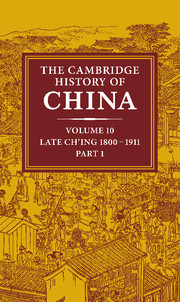Book contents
- Frontmatter
- 1 Introduction: the old order
- 2 Ch'ing Inner Asia c. 1800
- 3 Dynastic decline and the roots of rebellion
- 4 The Canton trade and the Opium War
- 5 The creation of the treaty system
- 6 The Taiping Rebellion
- 7 Sino-Russian relations, 1800–62
- 8 The heyday of the Ch'ing order in Mongolia, Sinkiang and Tibet
- 9 The Ch'ing Restoration
- 10 Self-strengthening: the pursuit of Western technology
- 11 Christian missions and their impact to 1900
- Bibliographical essays
- Bibliography
- Genealogical chart
- Glossary
- Index
- References
9 - The Ch'ing Restoration
Published online by Cambridge University Press: 28 March 2008
- Frontmatter
- 1 Introduction: the old order
- 2 Ch'ing Inner Asia c. 1800
- 3 Dynastic decline and the roots of rebellion
- 4 The Canton trade and the Opium War
- 5 The creation of the treaty system
- 6 The Taiping Rebellion
- 7 Sino-Russian relations, 1800–62
- 8 The heyday of the Ch'ing order in Mongolia, Sinkiang and Tibet
- 9 The Ch'ing Restoration
- 10 Self-strengthening: the pursuit of Western technology
- 11 Christian missions and their impact to 1900
- Bibliographical essays
- Bibliography
- Genealogical chart
- Glossary
- Index
- References
Summary
In July 1864, when the Taiping capital of Nanking was finally reduced by Tseng Kuo-fan's forces, many among China's scholar-official ruling class were already congratulating themselves on having witnessed a rare phenomenon in history - a dynasty that had reigned more than two hundred years, had seen glorious days and then declined, yet was able to defeat widespread and formidable rebellion. This was described in traditional historiography as restoration (chung-bsing, lit. ‘again rising’ or ‘rising at mid-course’), and it had occurred in but few instances since ancient times. The parallel often cited in the 1860s was the T'ang restoration in the reign of Su-tsung (756–72), when the great An Lu-shan Rebellion was suppressed.
In historical perspective, the Ch'ing restoration was perhaps even more remarkable than that of the T'ang. The imperial commanders of the eighth century were not far removed from the military-aristocratic culture of the Northern and Southern dynasties (317–589), but the scholar-officials of the late Ch'ing vanquished the Taipings in spite of more than a millennium of increasingly stultifying literary culture. Moreover, while the T'ang restoration saw the rise of virtually independent satrapies, Ch'ing imperial authority survived the rebellion largely intact: provincial governors-general and governors gained greater leeway in administration but nevertheless continued to depend on the throne's favour for their tenure of office. Just as T'ang Su-tsung had received aid from the Uighurs of central Asia, so the Ch'ing of the early T'ung-chih period profited by the direct and indirect assistance of the Western ‘barbarians’. But while the T'ang could count on the superior culture of the Middle Kingdom to overawe and even to assimilate their alien helpers, China in the nineteenth century was confronted by foreign peoples from overseas who not only were unassimilable but who also possessed a material culture superior to China's own.
- Type
- Chapter
- Information
- The Cambridge History of China , pp. 409 - 490Publisher: Cambridge University PressPrint publication year: 1978
References
- 13
- Cited by

